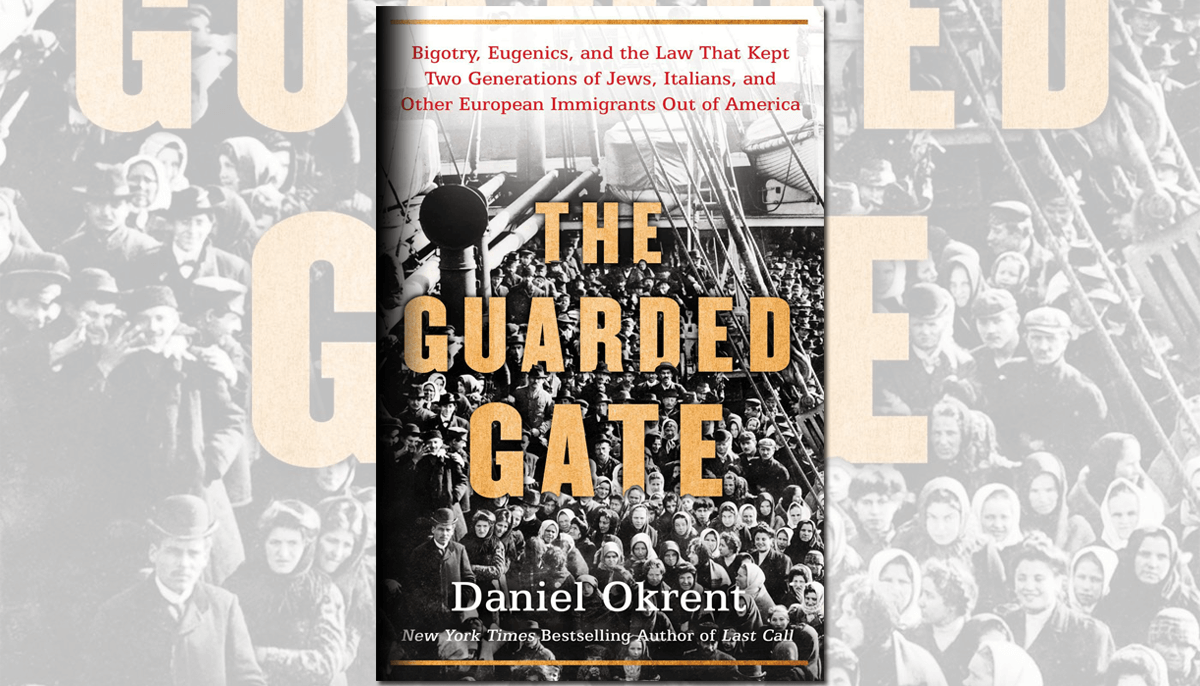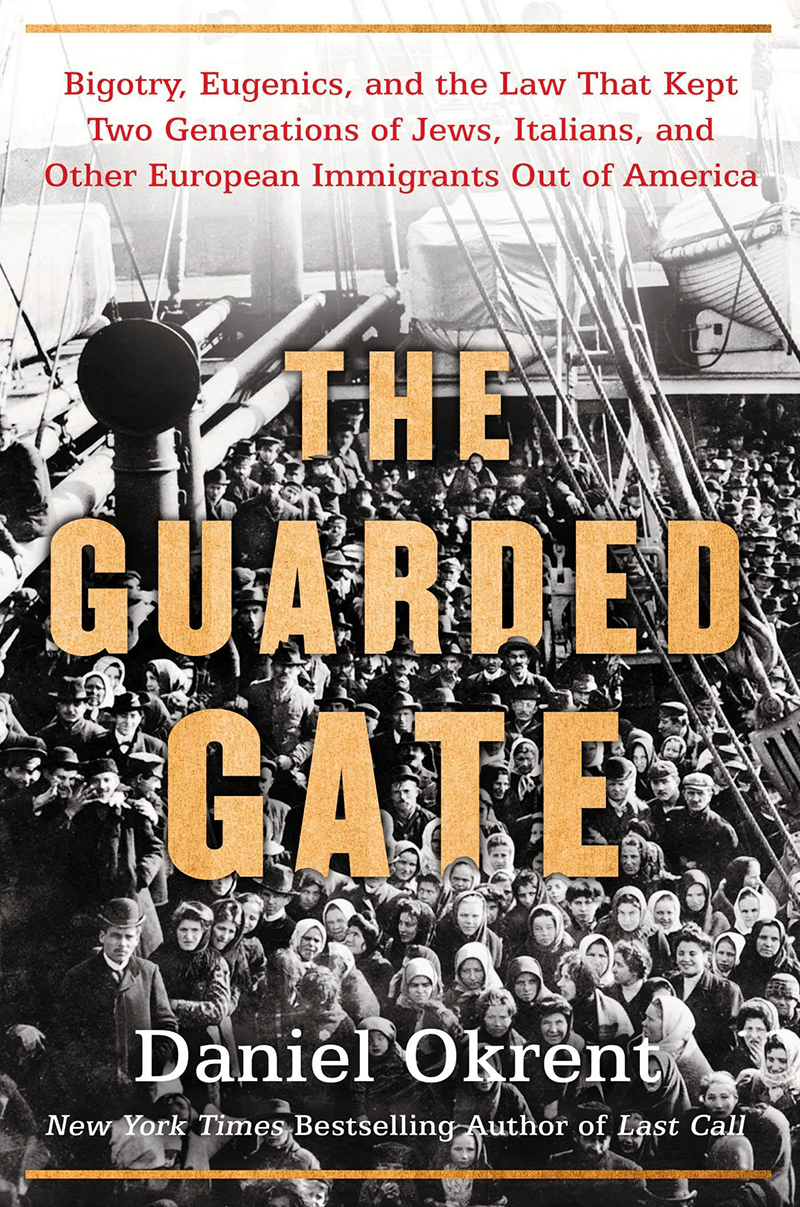
The Guarded Gate: Bigotry, Eugenics, and the Law That Kept Two Generations of Jews, Italians, and Other European Immigrants Out of America
by Daniel Okrent
Simon & Schuster, 2019, $32; 496 pages.
As reviewed by Ira Stoll
The jacket copy of Daniel Okrent’s new book, The Guarded Gate, describes it as “a work of history relevant for today.”
So it certainly is—in at least two senses.
The obvious one is how, in Okrent’s account, racism was a substantial factor in the passage of the Immigration Act of 1924—a law that effectively cut immigration to America in half based on quotas that preferred immigrants from Northern and Western Europe over those from Southern Europe, Eastern Europe, or Asia. For those inclined to see the current efforts at restricting illegal and legal immigration as similarly motivated, it might be mildly reassuring to know that today’s trend is not unprecedented. Or it may be all the more dismaying, if the current effort is a repeat of past mistakes rather than progress beyond them.
There is also a second, perhaps less-obvious way in which Okrent’s account resonates today—especially for those interested in education and philanthropy as well as immigration policy. This way has to do with seeing the 1924 episode as a case study in erroneous elite groupthink. Scholars at America’s most prestigious universities, backed by wealthy donors, influential newspapers, and powerful labor leaders, went off the rails. Their eugenics research, investigating the heritability of complex traits and associating them with racial groups, served their own preconceptions of progress, but it was groundless and deeply flawed science, lacking in rigor, cherrypicked, sloppy, disconnected from empirical reality, and morally untethered. It had disastrous public-policy consequences.
 Okrent is unsparing in documenting the leading role played by academics in the eugenics fad that contributed to the rewriting of our nation’s immigration law. It’s a story about a failure in higher education. Professors inspired by Charles Darwin’s work on natural selection and Gregor Mendel’s work on genetics became propagandists advancing the dangerous fantasy that a nation’s population could be perfected by government action to promote the “Nordic race” and its supposedly superior physical, moral, and intellectual traits over allegedly inferior Mediterranean, Asiatic, African, and Alpine types. The president of Stanford, David Starr Jordan, chaired the eugenics committee of the American Breeders Association and was a major fundraiser for the research. Edward Ross, the coiner of the phrase “race suicide,” had a doctorate from Johns Hopkins and taught at Stanford, the University of Nebraska, and the University of Wisconsin. One of the most prominent eugenicists, H. Fairfield Osborn, taught biology at Barnard. Other figures identified by Okrent as “critically important . . . in the spread of scientific racism and its application to the immigration issue” included professors Robert Yerkes and Ellsworth Huntington of Yale, Charles Conant Josey of Dartmouth, William McDougall and Edward East of Harvard, Carl Brigham of Princeton, and Roy Garis of Vanderbilt.
Okrent is unsparing in documenting the leading role played by academics in the eugenics fad that contributed to the rewriting of our nation’s immigration law. It’s a story about a failure in higher education. Professors inspired by Charles Darwin’s work on natural selection and Gregor Mendel’s work on genetics became propagandists advancing the dangerous fantasy that a nation’s population could be perfected by government action to promote the “Nordic race” and its supposedly superior physical, moral, and intellectual traits over allegedly inferior Mediterranean, Asiatic, African, and Alpine types. The president of Stanford, David Starr Jordan, chaired the eugenics committee of the American Breeders Association and was a major fundraiser for the research. Edward Ross, the coiner of the phrase “race suicide,” had a doctorate from Johns Hopkins and taught at Stanford, the University of Nebraska, and the University of Wisconsin. One of the most prominent eugenicists, H. Fairfield Osborn, taught biology at Barnard. Other figures identified by Okrent as “critically important . . . in the spread of scientific racism and its application to the immigration issue” included professors Robert Yerkes and Ellsworth Huntington of Yale, Charles Conant Josey of Dartmouth, William McDougall and Edward East of Harvard, Carl Brigham of Princeton, and Roy Garis of Vanderbilt.
As Okrent tells it, some of the academics were “committed progressives” who argued for outlawing child labor because doing so “would take away the poor’s incentive to breed.” The New York Times cheered; Okrent, who served a stint as public editor of that newspaper, has unearthed a 1921 editorial in which the Times warned of “swarms of aliens” bringing “diseases of ignorance and Bolshevism.” At a climactic moment in the immigration debate, the New York Times Book Review, under the headline, “Failure of the Melting Pot,” lavished praise on a pseudoscientific restrictionist book. Even the president of the American Federation of Labor, Samuel Gompers, himself a Jewish immigrant from England, described unrestricted immigration as a “pressing evil,” warning that “the persistence of racial characteristics” meant that America could be “overwhelmed” by outsiders.
Organized labor’s anxiety over increased competition from new arrivals and popular fear of “Bolshevism” doubtless did affect the 1924 law’s passage, though unions and anticommunism were also strong in the 1950s and 1960s, when the law was eventually revised to allow more immigration from places other than Northern and Western Europe. Disentangling historical causation can be complicated. Okrent doesn’t spend much time on possible alternative motives. Instead, he keeps his focus on the mountain of evidence about the role that eugenics played in the anti-immigration trend.
The academics were enabled by donors. Andrew Carnegie, the Scottish immigrant who built U.S. Steel, has a reputation as a brilliant philanthropist, but his Carnegie Institution of Washington was an early and enduring backer of some of the most misguided eugenics research. Another generous and crucial contributor was Mary Williamson Harriman. Her husband, Edward Henry Harriman, who controlled the Union Pacific and Southern Pacific railroads, died in 1909, leaving Mary a fortune worth about $2 billion in today’s dollars.
As recently as 1960, the president of Columbia, Grayson Kirk, contributed a foreword to a biography of Mary Williamson Harriman. The book itself described her “great interest in the vital subjects of heredity and of eugenics,” and credited her with congressional action “which has resulted not only in exclusion of citizens we cannot welcome to our country, but in the process of selection, in which direction our immigration is gradually tending. We are tending toward the selection of the best, the exclusion of the worst.”
“The University is privileged to be the instrument through which the memory and the work of one of the great women of the past generation may continue their influence upon the future,” Kirk wrote in the foreword, asserting, “Hers was a life to confound and refute the critics of wealth.”
If that particular lesson may not be precisely the correct one to draw from this episode, then what is?
Readers of The Guarded Gate will come away with reinvigorated appreciation of the need to be wary of consensus-based conclusions emanating from internationally acclaimed academic experts. Sometimes, as in this case, the scientific consensus is wrong. Even if the science had been correct, the policy recommendations wouldn’t logically or morally follow. Okrent tells of one prominent figure in American eugenics, Harry Laughlin. Laughlin, who earned a doctorate in biology from Princeton, testified before the congressional committee that changed the immigration law. He favored “continuous decimal elimination,” barring the bottom 10 percent of the population, including “defectives and degenerates” such as deaf, blind, feebleminded, inebriate, “criminalistic” or epileptic individuals, from having children. Laughlin was honored in absentia with an honorary doctorate from the University of Heidelberg, Germany’s oldest university, at a ceremony featuring the Nazi propaganda minister, Joseph Goebbels.
A more hopeful theme is that science, and academia, have the capacity to self-correct. Heroes of Okrent’s account include several academics whose lives spanned the late 19th and early 20th centuries, when the eugenics movement was at its height: Samuel G. Smith of the University of Minnesota; Hebert Spencer Jennings, a Harvard-trained zoologist who was a professor at Johns Hopkins, and Franz Boas, a professor of anthropology at Columbia. They used evidence carefully to show statistical manipulation by the eugenicists.
The story Okrent tells is newly relevant, but it isn’t entirely new; Harvard’s Stephen Jay Gould covered the science in his 1981 book The Mismeasure of Man; and the historian John Higham, Okrent’s teacher at the University of Michigan, covered the nativist origins of the immigration law in his 1955 book Strangers in the Land.
The counterarguments to eugenics were either too late or insufficient to dissuade Congress, which acted overwhelmingly; the Immigration Act of 1924 passed 308–62 in the House and 69–9 in the Senate and was signed into law by President Calvin Coolidge.
The new law had far-reaching consequences. One small example: Max Fidlon had departed Minsk for New York in 1924, leaving his wife and then 9-year-old son, Sidney, behind, with the expectation that they would quickly follow. The change in law meant that young Sidney Fidlon would be separated from his father for five years. The trauma of the time apart was inescapable. But after Sidney did reach the United States in 1929, the years of separation that had resulted from efforts to exclude “the worst” did not diminish his gratitude toward, and patriotism for, his new home. At least as could best be ascertained by this book reviewer, his grandson.
Ira Stoll is the managing editor of Education Next.


